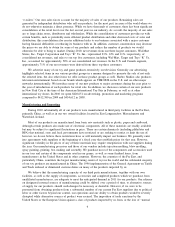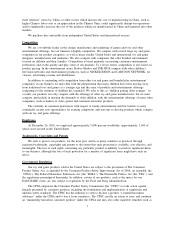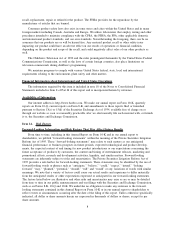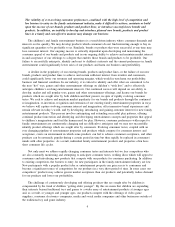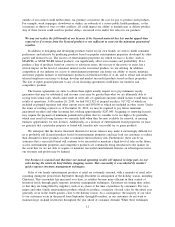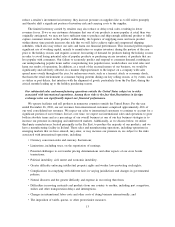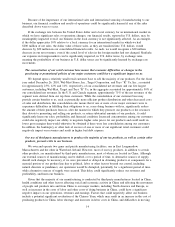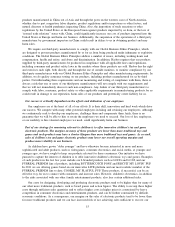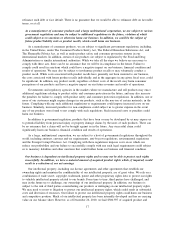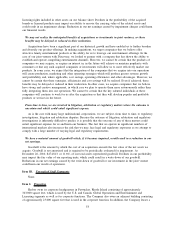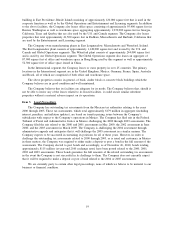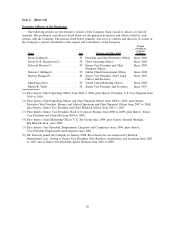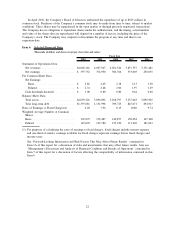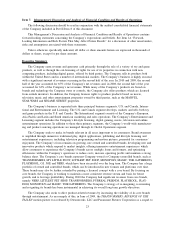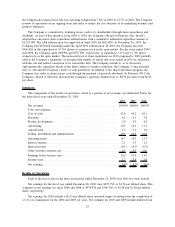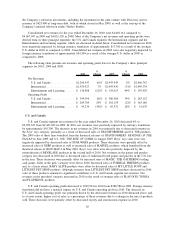Hasbro 2010 Annual Report Download - page 26
Download and view the complete annual report
Please find page 26 of the 2010 Hasbro annual report below. You can navigate through the pages in the report by either clicking on the pages listed below, or by using the keyword search tool below to find specific information within the annual report.costs. In addition, the pace of change in product offerings and consumer tastes in the electronics area is
potentially even greater than for our other products. This pace of change means that the window in which a
product can achieve and maintain consumer interest may be even shorter than traditional toys and games.
We rely on external financing, including our credit facility, to help fund our operations. If we were
unable to obtain or service such financing, or if the restrictions imposed by such financing were too
burdensome, our business would be harmed.
Due to the seasonal nature of our business, in order to meet our working capital needs, particularly those
in the third and fourth quarters, we rely on our revolving credit facility and our other credit facilities for
working capital. We currently have a revolving credit agreement that expires in 2014, which provides for a
$500,000 committed revolving credit facility. The credit agreement contains certain restrictive covenants
setting forth leverage and coverage requirements, and certain other limitations typical of an investment grade
facility. These restrictive covenants may limit our future actions, and financial, operating and strategic
flexibility. In addition, our financial covenants were set at the time we entered into our credit facility. Our
performance and financial condition may not meet our original expectations, causing us to fail to meet such
financial covenants. Non-compliance with our debt covenants could result in us being unable to utilize
borrowings under our revolving credit facility and other bank lines, a circumstance which potentially could
occur when operating shortfalls would most require supplementary borrowings to enable us to continue to fund
our operations.
In early 2011 we established a commercial paper program which, subject to market conditions, will allow
us to issue up to $500,000 in aggregate amount of commercial paper outstanding from time to time as a
further source of working capital funding and liquidity. We did not renew our accounts receivable securitiza-
tion facility in January 2011 as we believe issuing commercial paper can be a more cost effective way for us
to raise short-term funding in the future. However, there is no guarantee that we will be able to issue
commercial paper on favorable terms, or at all, at any given point in time.
We believe that our cash flow from operations, together with our cash on hand and access to existing
credit facilities or our commercial paper program, are adequate for current and planned needs in 2011.
However, our actual experience may differ from these expectations. Factors that may lead to a difference
include, but are not limited to, the matters discussed herein, as well as future events that might have the effect
of reducing our available cash balance, such as unexpected material operating losses or increased capital or
other expenditures, or other future events that may reduce or eliminate the availability of external financial
resources.
Not only may our individual financial performance impact our ability to access sources of external
financing, but significant disruptions to credit markets in general may also harm our ability to obtain financing.
Although we believe the risk of nonperformance by the counterparties to our financial facilities is not
significant, in times of severe economic downturn and/or distress in the credit markets, it is possible that one
or more sources of external financing may be unable or unwilling to provide funding to us. In such a situation,
it may be that we would be unable to access funding under our existing credit facilities, and it might not be
possible to find alternative sources of funding.
We also may choose to finance our capital needs, from time to time, through the issuance of debt
securities. Our ability to issue such securities on satisfactory terms, if at all, will depend on the state of our
business and financial condition, any ratings issued by major credit rating agencies, market interest rates, and
the overall condition of the financial and credit markets at the time of the offering. The condition of the credit
markets and prevailing interest rates have fluctuated significantly in the past and are likely to fluctuate in the
future. Variations in these factors could make it difficult for us to sell debt securities or require us to offer
higher interest rates in order to sell new debt securities. The failure to receive financing on desirable terms, or
at all, could damage our ability to support our future operations or capital needs or engage in other business
activities.
As of December 26, 2010, we had $1,384,895 of total principal amount of indebtedness outstanding. If
we are unable to generate sufficient available cash flow to service our outstanding debt we would need to
16


